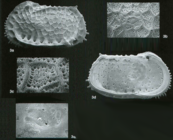
| Intro | | About | | Wiki | | Search traits | | Data explorer | | Literature | | Definitions | | Sources | | Webservices | | Statistics | | Feedback | | Editors | | Log in |
Ostracoda taxon detailsBradleya perforata Jellinek & Swanson, 2003
395827 (urn:lsid:marinespecies.org:taxname:395827)
accepted
Species
marine,
Jellinek, T. & Swanson, K.M. (2003). Report on the taxonomy, biogeography and phylogeny of mostly living benthic Ostracoda (Crustacea) from deep-sea samples (Intermediate Water depths) from the Challenger Plateau (Tasman Sea) and Campbell Plateau (Southern Ocean), New Zealand. <em>Abhandlungen der Senckenbergischen Naturforschenden Gesellschaft.</em> 558:1-329. (look up in IMIS) [details] Available for editors
Type locality contained in Campbell Plateau
type locality contained in Campbell Plateau [details]
Description Shape sub-rectangular; anterior end obliquely rounded in LV and more evenly rounded in RV. Ventral outline slightly convex;...
Description Shape sub-rectangular; anterior end obliquely rounded in LV and more evenly rounded in RV. Ventral outline slightly convex; dorsal outline more or less straight with an obvious angle in the LV above the eye tubercle. Dorsal outline interrupted by 4-5 tiny spines. LV with a well-developed spine at the posterior cardinal angle. Posterior outline rounded in the lower two thirds and angular in the upper third. Anterior ornamented with approx. 18 tiny spines in the lower two thirds of the total height, whereas the posterior end shows lOII partially longer spines. Dorsal ridge well developed, sloping from the posterior cardinal angle towards the anterior, slightly in front and above the central muscle scar area. Ventral ridge thick, with a strong terminal posterior spine and a secondary spine behind. The ventral ridge curves into an almost suppressed ocular ridge that runs parallel to the anterior outline and up to the well-devel. [details] Etymology From perforatus (latin) = perforate; according to the perforate valve surface.
Etymology From perforatus (latin) = perforate; according to the perforate valve surface. [details]
Brandão, S. N.; Antonietto, L. S.; Pereira, J. S.; Pereira, S. G. G.; Sá, H. A. B.; Praxedes, R. A.; Sabater, L. M., Santos, S.G.; Karanovic, I. (2025). World Ostracoda Database. Bradleya perforata Jellinek & Swanson, 2003. Accessed at: https://www.marinespecies.org/ostracoda/aphia.php?p=taxdetails&id=395827 on 2025-05-22
Date action by 2009-05-27 13:36:22Z created db_admin
original description
Jellinek, T. & Swanson, K.M. (2003). Report on the taxonomy, biogeography and phylogeny of mostly living benthic Ostracoda (Crustacea) from deep-sea samples (Intermediate Water depths) from the Challenger Plateau (Tasman Sea) and Campbell Plateau (Southern Ocean), New Zealand. <em>Abhandlungen der Senckenbergischen Naturforschenden Gesellschaft.</em> 558:1-329. (look up in IMIS) [details] Available for editors
additional source Webber, W.R., G.D. Fenwick, J.M. Bradford-Grieve, S.G. Eagar, J.S. Buckeridge, G.C.B. Poore, E.W. Dawson, L. Watling, J.B. Jones, J.B.J. Wells, N.L. Bruce, S.T. Ahyong, K. Larsen, M.A. Chapman, J. Olesen, J.S. Ho, J.D. Green, R.J. Shiel, C.E.F. Rocha, A. Lörz, G.J. Bird & W.A. Charleston. (2010). Phylum Arthropoda Subphylum Crustacea: shrimps, crabs, lobsters, barnacles, slaters, and kin. <em>in: Gordon, D.P. (Ed.) (2010). New Zealand inventory of biodiversity: 2. Kingdom Animalia: Chaetognatha, Ecdysozoa, Ichnofossils.</em> pp. 98-232 (COPEPODS 21 pp.). [details] Available for editors  Present Present  Inaccurate Inaccurate  Introduced: alien Introduced: alien  Containing type locality Containing type locality
From editor or global species database
Description Shape sub-rectangular; anterior end obliquely rounded in LV and more evenly rounded in RV. Ventral outline slightly convex; dorsal outline more or less straight with an obvious angle in the LV above the eye tubercle. Dorsal outline interrupted by 4-5 tiny spines. LV with a well-developed spine at the posterior cardinal angle. Posterior outline rounded in the lower two thirds and angular in the upper third. Anterior ornamented with approx. 18 tiny spines in the lower two thirds of the total height, whereas the posterior end shows lOII partially longer spines. Dorsal ridge well developed, sloping from the posterior cardinal angle towards the anterior, slightly in front and above the central muscle scar area. Ventral ridge thick, with a strong terminal posterior spine and a secondary spine behind. The ventral ridge curves into an almost suppressed ocular ridge that runs parallel to the anterior outline and up to the well-devel. [details]Diagnosis A medium-sized Bradleya species, showing unique micro-perforation and punctuations as secondary reticulation inside of the primary reticulation. [details] Etymology From perforatus (latin) = perforate; according to the perforate valve surface. [details] |

